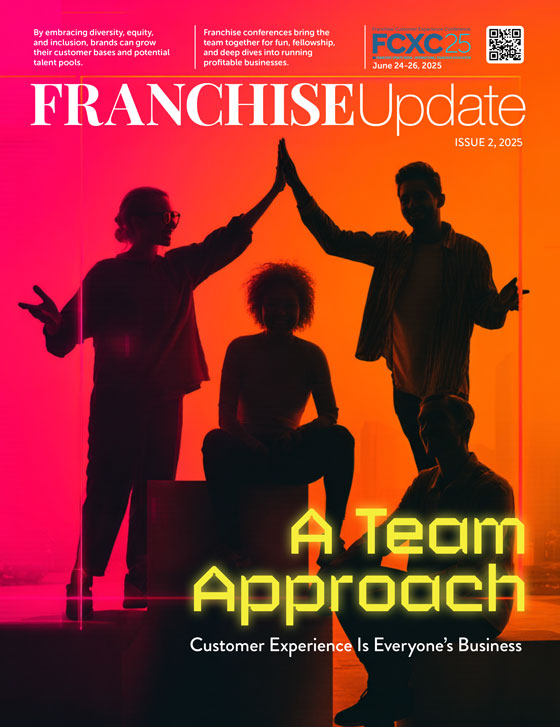Creating the Customer Experience: When Departments Collaborate and Embrace Technology, Brands Win

When leaders at Edible Brands first proposed the idea of one-hour delivery, internal stakeholders were skeptical, saying there were too many logistical hurdles and ways it could fail.
“We heard 1,000 reasons why we couldn’t do it, but then we came up with 1,000 reasons why we could,” says Kevin Keith, Edible’s chief marketing officer. “It’s been one of our most successful launches to date.”
The effort required cross-functional collaboration. By bringing together operations, tech, marketing, e-commerce, and data analytics teams, Edible mapped out every potential breakdown, from inventory shortages to driver delays, and built layers of well-tested backups, transforming a risky idea into a reliable, competitive edge.
Modern franchisors like Edible are increasingly breaking down silos to embrace a next-generation approach that leverages data, AI, and collaborative thinking to deliver a seamless customer experience at every touchpoint.
Strong cross-functional alignment can create connected experiences that pay off. Research by Forrester shows that marketing, digital, and customer experience (CX) teams who are highly aligned report 1.6 times faster revenue growth and 1.4 times better customer retention than their peers.
All hands on deck
Brands are no longer built on buzzy advertising campaigns and traditional marketing. These days, the real magic happens within the CX, and it takes every department working together to get it right.
Marketing is the customer experience, says Keith, a seasoned pro at implementing transformational strategies. He served as chief brand officer of Orangetheory Fitness before joining Edible in 2023.
“We’ve talked about creating that ‘wow’ since we were first founded in 1999,” Keith says. “Today, that ‘wow’ for Edible is convenience, speed, and ease in gifting. Those three things have to be singing in concert from a brand standpoint.”
In this era where customers expect fast responses, friction-free experiences, and personalized service, falling short isn’t an option.
Five9’s 2025 Customer Experience Report found that 40% of consumers will stop doing business with a company after one bad experience, and 95% share negative experiences with others.
At Edible, Keith daily quarterbacks cross-functional strategy to support franchisees and drive collective CX success through a tightly integrated approach. Decisions aren’t made in isolation. Instead, teams spanning departments, like marketing, operations, tech, user experience, and legal, are constantly testing, tweaking, and co-creating in real time.
Twice a week, leaders gather in a large conference room at Edible’s Atlanta headquarters to review sales, traffic, and CX metrics and make data-driven adjustments on the spot.
Meanwhile, centralized communication strategies, like the weekly digital Growth Gazette, keep franchisees in the loop with operations, ensuring consistency across the brand’s 700-plus global locations.
“There’s really no way to hide in a silo at Edible because there are no silos,” Keith says.
The catalyst
Coordinating a unified vision across franchise networks is complex, but cloud-based platforms, AI analytics, project management tools, and other modern technology solutions are bridging communication and information-sharing gaps.
AlphaGraphics continues to experience the power of cross-organizational collaboration with the 2024 launch of LeadFlow, says Stephanie Johnson, the brand’s vice president of marketing. The lead-management and CX platform leverages AI-powered call scoring to analyze customer sentiment, track conversions, and instantly identify coaching opportunities for franchisees.
Securing executive buy-in and building a cross-functional leadership team was key to the integration, where each department had clearly defined roles, Johnson says. Multiple departments played a part:
- Marketing mapped the customer journey and built an in-house digital services team to drive demand.
- Sales developed lead-handling scripts and processes.
- The technology team integrated tools, like Invoca and the brand’s CMS, for tracking and coaching.
- The learning and development team onboarded and trained franchisees to use LeadFlow.
- Operations embedded the program into franchise standards and support.
Johnson says the input of an advisory committee of franchise owners was crucial to shaping the platform, ensuring the program addressed real-world needs and secured franchisee support across the primarily B2B brand’s 270-plus locally owned and operated centers.
LeadFlow is central to AlphaGraphics’ rhythm, Johnson says. It’s reviewed in performance groups, discussed in franchise advisory meetings, and used for marketing benchmarks. She credits the power of centralized technology for scaling the impact of the Colorado-based brand.
“Instead of simply coaching a new way to answer the phone, for example, we can now use AI to listen to calls, provide automated coaching, and deliver performance scores,” Johnson says. “This gives us the ability to measure and improve customer experience both nationally and at the individual center level, turning insights into consistent, actionable outcomes across the network.”
Beyond call analytics, the brand uses predictive analysis to flag underperforming centers and offer proactive support and AI-driven bidding tools to optimize Google Ads for franchise locations.
“More than anything, we invest in franchisee confidence,” Johnson says. “When they understand the why behind our CX standards, they’re more committed to executing them with excellence.”
Transparency
With 187 locations in the U.S. and Canada, Goldfish Swim School relies on transparency and teamwork to deliver a friction-free digital experience for families and franchisees.
“This is an ongoing project involving constant collaboration between our marketing, operations, and technology teams to ensure lead and conversion journeys are easy to follow through to completion and the data flows into the right systems for follow-up and registration,” says Shana Krisan, Goldfish Swim School’s chief marketing officer. “With the number of channels now flowing into the website, the information must be accurate and timely, and both our external and internal customers are getting what they want and need with the best experience possible.”
To continually optimize CX processes and maintain alignment, Goldfish employs:
- Regular cross-departmental meetings
- Shared goals and KPIs
- Collaborative project management tools
- Quarterly and annual planning sessions
A unified vision and shared accountability are in place to address brand-specific challenges, such as seasonality, fluctuating enrollment rates, and sales conversion efforts.
“Our approach centers on the understanding that operational efficiency and customer experience are inseparable,” Krisan says. “They’ve become essential for delivering seamless experiences and satisfied customers, directly driving our bottom line.”
Delivering
There is no one-size-fits-all collaboration formula for a compelling CX. It starts with understanding customers’ needs and how they value a product, service, or brand and want to engage physically and digitally.
Managing customers’ evolving expectations while maintaining trust and speed through technology will continue to challenge those tracking the quality experience. A recent eMarketer report reveals that 24/7 availability and human-assisted customer service via phone calls or live chats will be the most important CX features in the next three to five years.
Family-focused Goldfish Swim School prioritizes convenience, personal connections, and real-time communication to provide prompt and genuine support, says Mike Skitzki, chief operating officer.
“Texting enables us to meet parents where they are, on their phones, while maintaining the human touch that builds trust and drives meaningful relationships with our members,” Skitzki says. “Making that possible takes close collaboration between our operations, marketing, and technology teams to ensure the experience is seamless and consistent across every location.”
AlphaGraphics empowers its print and marketing clients with self-service tools designed to simplify the ordering process for print and branded materials. The proprietary web-to-print platform agOnline offers businesses a private, custom storefront, which is accessible anytime, to order and manage assets. The same technology drives the brand’s National Programs initiative that helps multi-unit location businesses streamline orders across networks with a centralized, efficient system.
“We lead with human and back it up with digital,” Johnson says. “That means making sure calls are answered live, questions are responded to promptly, and that there’s always someone local to talk to. But we also offer tools like agOnline, so customers who want to self-serve at midnight can still get what they need.”
Feedback and innovation
To truly understand the customer, brands need more than just data; they need the correct data tailored to different teams and goals. Paired with qualitative feedback, these insights help track performance, justify investments, measure the impact of CX improvements, set shared targets for the future, and identify problems before they spiral.
While franchisors use numerous metrics to make decisions based on a shared objective, eMarketer research finds the customer satisfaction score (CSAT) and net promoter score (NPS) remain the go-to measurements to gauge success across the customer journey.
Keith was introduced to NPS via an email survey two years ago, and he says it has dramatically improved the customer experience. After every transaction, the brand asks a simple question: “Would you recommend Edible to a friend or a family member?” It has allowed operations to catch and enhance performance issues early. Daily dashboard reviews highlight problems, track trends, and ensure quick action by local franchisees and follow-up customer support, if needed, from corporate.
“I can’t market my way out of a bad NPS,” Keith says. “If people don’t want to recommend our brand because of a bad operational issue or a bad technology experience, I can’t recapture that customer. So, it’s best to keep a customer because acquiring a new customer costs so much more.”
Customer feedback has significantly shaped marketing strategies and operational decisions at Jeff’s Bagel Run, which has been franchising since 2024. The rapidly emerging brand’s homegrown tech stack fuels a vast amount of CX data derived from the brand’s app and in-store operations.
“That data doesn’t live in a vacuum; it’s shared across all departments, and our tech team works closely with marketing, operations, and customer service to interpret it and take action,” says Catriona Harris, vice president of marketing for Florida-based Jeff’s Bagel Run.
If feedback shows confusion around a promotion, marketing can adjust messaging on the fly. Consistent customer complaints about delays or friction in the order flow give ops and tech a window to work together to improve processes or update tools.
“This level of visibility and cross-functional collaboration allows us to be more responsive, guest-focused, and continually improve the experience not just for customers, but for our in-store teams as well,” Harris says.
Tight feedback loops between the quick-service bagel shop brand’s departments can help identify and resolve challenges quickly, ensuring a seamless customer experience while remaining nimble at every step.
When Jeff’s Bagel Run first launched espresso drinks, employees initially used the old-school Starbucks method of writing orders on cups with markers. The technique quickly became chaotic, prompting a switch to an adhesive label system with native integration into the brand’s existing tech. The new strategy rolled out in a couple of months, but it might have taken a couple of years with external partners, notes Aaron LeClair, Jeff’s Bagel Run’s vice president of technology.
“We actually had a team member in one of our stores bring it to our attention,” LeClair says. “Recognizing the need for a quick adjustment, we were able to pivot immediately and come up with a better solution.”
In franchising, where consistency is everything and customers’ expectations continue to rise and change, brands will need to push experience-driven collaboration further. Experts advise a practical blueprint for franchise brands struggling with silos between departments or locations. It’s important to focus on clear communication, collaboration tools, and measurable results.
At February’s International Franchise Association (IFA) Annual Convention, Johnson took part in a CX roundtable. Notable trends emerged:
- The rise of lead scoring to prioritize and personalize customer interactions
- The balance between outsourcing inbound calls to AI or call centers versus investing in team training
- An increasing use of automated texts and phone calls to streamline updates and confirmations without compromising the personal touch
“Technology can support a great customer experience, but it can’t replace genuine connection,” Johnson says. “The franchisors who win will be the ones who make people the priority and use tech to scale that human impact.”
Tech Case Study: Jeff’s Bagel Run
While established brands can struggle with siloed departments and disjointed strategies, often leading to inconsistent customer experiences, Jeff’s Bagel Run baked collaboration into its franchise DNA.
“Our approach has always been to build with integration in mind not just between systems but between teams,” says Aaron LeClair, Jeff’s Bagel Run’s vice president of technology. “Tech, ops, and marketing collaborate on everything we roll out from day one. That alignment lets us move fast, adapt quickly, and deliver a seamless customer experience that drives efficiency as we scale.”
Homegrown tech
Founded in 2019, Jeff’s Bagel Run launched its franchising program in 2024 to meet the demand for the brand’s authentic New York-style bagels, which are hand rolled, slow proofed overnight, boiled, and then baked fresh throughout the day.
Rather than relying on off-the-shelf solutions, leadership designed its own in-house tech stack to reduce waste and streamline operations without sacrificing the quality of the product or guest experience.
LeClair says that developing the framework to support day-to-day store operations and brand-wide consistency was a highly collaborative effort:
- Operations identified daily friction points (inventory, order flow, and scheduling) to prioritize tools that support frontline teams working in the stores.
- Marketing and loyalty weighed in on integrating guest engagement and personalization without relying on third-party systems.
- Input from finance and reporting shaped the look of real-time dashboards and automated data pulls for smart, fast decisions.
The system uses machine learning to predict daily bagel production needs, reducing waste and optimizing inventory management. It also integrates front-of-house and back-of-house operations for seamless communication.
“Because we built everything in-house, we were able to stay nimble, iterating quickly and making adjustments based on frontline feedback,” LeClair says. “Every department had a seat at the table, which meant we weren’t just designing tech for tech’s sake; we were solving real problems with intentional solutions that align with how we operate and grow.”
Staying agile
With 12 stores open and 78 under development, Jeff’s Bagel Run’s alignment is proving its worth, creating what LeClair calls a huge advantage as the brand grows.
Whether launching a new promotion, updating the loyalty program, or implementing an in-store process change, the company can roll changes out rapidly and consistently across all locations.
Today, the only nonproprietary technology in the stores is payment processing integrations and third-party delivery partnerships. Everything else is custom-built, allowing the team to start with the guest experience and work backward, LeClair says. Customer and frontline team feedback drives continual improvement and innovation.
Franchise marketing tactics and the brand’s recently launched loyalty program were built with the same unified, guest-centric focus. Marketing, tech, and operations teams joined forces to study customer habits and create a simple points system tied into the app and in-store purchases while leaving room for special promotions and rewards. Catriona Harris, vice president of marketing for Jeff’s Bagel Run, says the goal is to build genuine connections, not just track purchases.
“Early results have been really encouraging. We’re seeing strong sign-ups, high redemption rates, and increased frequency among our loyalty members,” Harris says. “One thing we’ve learned is how much people love being recognized even in small ways. We’ve also seen how the program gives us better data to personalize our marketing and deepen our relationship with each guest.”
Harris highlights several strategies that continue to prevent the brand from working in silos and help make sure that solutions actually work in practice and at scale:
- Weekly cross-functional meetings unite marketing, operations, customer service, and tech to align priorities, share feedback, and work through upcoming initiatives as a unified team.
- The brand’s tech team regularly spends time in stores, working side by side with the teams. That firsthand exposure helps them deeply understand the day-to-day challenges and opportunities, which leads to smart, relevant solutions.
- The brand leverages its network of corporate stores as a real-world testing ground. With tech, ops, and marketing teams having access to the same environments, they can iterate quickly and collaboratively, grounded in real insight, not assumptions.
Share this Feature
Recommended Reading:
FRANCHISE TOPICS
- Multi-Unit Franchising
- Get Started in Franchising
- Franchise Growth
- Franchise Operations
- Open New Units
- Franchise Leadership
- Franchise Marketing
- Technology
- Franchise Law
- Franchise Awards
- Franchise Rankings
- Franchise Trends
- Franchise Development
- Featured Franchise Stories
FEATURED IN

Franchise Update Magazine: Issue 2, 2025
| ADVERTISE | SPONSORED CONTENT |








 The franchise listed above are not related to or endorsed by Franchise Update or Franchise Update Media Group. We are not engaged in, supporting, or endorsing any specific franchise, business opportunity, company or individual. No statement in this site is to be construed as a recommendation. We encourage prospective franchise buyers to perform extensive due diligence when considering a franchise opportunity.
The franchise listed above are not related to or endorsed by Franchise Update or Franchise Update Media Group. We are not engaged in, supporting, or endorsing any specific franchise, business opportunity, company or individual. No statement in this site is to be construed as a recommendation. We encourage prospective franchise buyers to perform extensive due diligence when considering a franchise opportunity.